Xerox DCP-7030, DCP-7040, DCP-7045N, MFC-7320, MFC-7340 Service Manual
...
Laser Multi-Function Center
SERVICE MANUAL
MODEL:
DCP-7030/7040/7045N MFC-7320/7340/7440N/7450/
7840N/7840W
Read this manual thoroughly before carrying out any maintenance work.
Keep this manual in a convenient place for quick and easy reference at all times.
Jan 2008 SM-FAX088 8C5C
Confidential
© Copyright Brother Industries, Ltd. 2008
Compilation and Publication:
This manual has been complied and published, under the supervision of Brother Industries Ltd., covering the latest product descriptions and specifications. The contents of this manual and the specifications of this product are subject to change without notice. Brother reserves the right to make changes without notice in the specifications and materials contained herein and shall not be responsible for any damages (including consequential) caused by reliance on the materials presented, including but not limited to typographical and other errors relating to the publication. This product is designed for use in a professional environment.
Confidential
PREFACE
This service manual contains basic information required for after-sales service of the Laser Multi-Function Center (hereinafter referred to as "the machine"). This information is vital to the service personnel to maintain the high printing quality and performance of the machine.
This service manual covers the DCP-7030/7040/7045N, MFC-7320/7340/7440N/7450/ 7840N/7840W machines.
This manual consists of the following chapters:
CHAPTER 1: TROUBLESHOOTING
Details of error messages and codes that the incorporated self-diagnostic function of the machine will display if any error or malfunction occurs. If any error message appears, refer to this chapter to find which parts should be checked or replaced.
The latter half of this chapter provides sample problems that could occur in the main sections of the machine and related troubleshooting procedures.
CHAPTER 2: PERIODICAL MAINTENANCE
Details of consumable parts and periodical maintenance parts. This chapter also covers procedures for disassembling and assembling periodical maintenance parts.
CHAPTER 3: DISASSEMBLY AND ASSEMBLY
Details of procedures for disassembling and assembling of the machine together with related notes. The disassembly order flow provided enables you to see at a glance the quickest way to get to parts involved.
At the start of a disassembly job, you can check the disassembly order flow that guides you through a shortcut to get to the object parts.
This chapter also covers screw tightening torques and lubrication points to which the specified lubrications should be applied during assembly jobs.
CHAPTER 4: ADJUSTMENTS AND UPDATING OF SETTINGS, REQUIRED AFTER PARTS REPLACEMENT
Details of adjustments and updating of settings, which are required if the main PCB and some other parts have been replaced. This chapter also covers how to update the firmware.
CHAPTER 5: SERVICE FUNCTIONS
Describes the maintenance mode which is exclusively designed for the purpose of checking the settings and adjustments using the keys on the panel.
This chapter also covers hidden function menus, which activate settings and functions or reset the parts life.
CHAPTER 6: CIRCUIT DIAGRAMS, WIRING DIAGRAM
Provides the Circuit Diagrams and Wiring Diagram for the connections of the PCBs.
i |
Confidential |
APPENDIX 1: WORKER SWITCH Settings (WSW) APPENDIX 2: DELETION OF PERSONAL INFORMATION APPENDIX 3: SERIAL NUMBERING SYSTEM APPENDIX 4: SCREW CATALOGUE
APPENDIX 5: GLOSSARY
APPENDIX 6: REFERENCES
Information in this manual is subject to change due to improvement or redesign of the product. All relevant information in such cases will be supplied in service information bulletins (Technical Information).
A thorough understanding of this machine, based on information in this service manual and service information bulletins, is required for maintaining its print quality performance and for improving the practical ability to find the cause of problems.
There is the service reference manual as well. This service reference manual contains “SPECIFICATIONS”, “THEORY OF OPERATION”, “TONER CARTRIDGE WEIGHT INFORMATION”, “REFERENCES”, and “GLOSSARY”.
ii |
Confidential |
TABLE OF CONTENTS
PREFACE .................................................................................................................... |
|
i |
||
REGULATION ......................................................................................................... |
viii |
|||
SAFETY INFORMATION .......................................................................................... |
xii |
|||
CHAPTER 1 |
TROUBLESHOOTING ................................................................... |
1-1 |
||
1. |
INTRODUCTION ......................................................................................................................... |
1-1 |
||
|
1.1 |
Precautions ......................................................................................................................... |
1-1 |
|
|
1.2 |
Part names ......................................................................................................................... |
1-2 |
|
|
1.3 |
Initial Check ........................................................................................................................ |
1-4 |
|
2. |
ERROR CAUSE .......................................................................................................................... |
1-6 |
||
|
2.1 |
Error indication .................................................................................................................... |
1-6 |
|
|
2.2 |
Error Code Cause and Remedy ......................................................................................... |
1-7 |
|
|
|
2.2.1 |
Recoverable User Check Errors ............................................................................ |
1-7 |
|
|
2.2.2 |
Service Call Error ................................................................................................... |
1-7 |
3. |
PAPER FEEDING PROBLEMS ................................................................................................. |
1-23 |
||
|
3.1 |
No Feeding ....................................................................................................................... |
1-23 |
|
|
3.2 |
Double Feeding ................................................................................................................ |
1-23 |
|
|
3.3 |
Paper Jam ........................................................................................................................ |
1-24 |
|
|
3.4 |
Dirt on Paper ..................................................................................................................... |
1-25 |
|
|
3.5 |
Wrinkles or creases .......................................................................................................... |
1-25 |
|
|
3.6 |
Waves in the paper / folds in the paper at the eject roller 2 .............................................. |
1-25 |
|
|
3.7 |
Curl in the paper ............................................................................................................... |
1-26 |
|
4. TROUBLESHOOTING OF DOCUMENT FEEDING .................................................................. |
1-27 |
|||
|
4.1 |
No Feeding ....................................................................................................................... |
1-27 |
|
|
4.2 |
Double feeding ................................................................................................................. |
1-27 |
|
|
4.3 |
Paper Jam ........................................................................................................................ |
1-28 |
|
5. IMAGE DEFECT TROUBLESHOOTING (Defect Of the Print) .................................................. |
1-29 |
|||
|
5.1 |
Image Defect Examples .................................................................................................... |
1-29 |
|
|
5.2 |
Diameter of Rollers ........................................................................................................... |
1-29 |
|
|
5.3 |
Troubleshooting Image Defect .......................................................................................... |
1-30 |
|
6. |
TROUBLESHOOTING OF SCANNIG ....................................................................................... |
1-43 |
||
|
6.1 |
Cannot scan the document in the FB unit. |
|
|
|
|
(If scan the document, it is completely white or black.) .................................................... |
1-43 |
|
6.2Cannot scan the document in the ADF unit.
|
(If scan the document, it is completely white or black.) .................................................... |
1-43 |
6.3 |
Print of the scanning document is light or dark ................................................................. |
1-44 |
6.4 |
Vertical streaks (White or Black vertical streaks) .............................................................. |
1-44 |
iii |
Confidential |
|
6.5 |
Poor fixing ......................................................................................................................... |
1-44 |
|
6.6 |
Image distortion ................................................................................................................ |
1-44 |
7. |
SOFTWARE SETTING PROBLEMS ......................................................................................... |
1-45 |
|
8. |
NETWORK PROBLEMS ........................................................................................................... |
1-46 |
|
9. |
TROUBLESHOOTING OF THE COMMUNICATIONS ERROR ................................................ |
1-47 |
|
10. |
Troubleshooting of the control panel ......................................................................................... |
1-51 |
|
11. |
Troubleshooting of fax functions ................................................................................................ |
1-53 |
|
12. OTHERS PROBLEMS ............................................................................................................... |
1-57 |
||
CHAPTER 2 |
PERIODICAL MAINTENANCE ...................................................... |
2-1 |
||
1. |
CONSUMABLE PARTS ............................................................................................................... |
2-1 |
||
2. |
PERIODICAL PEPLACEMENT PARTS ...................................................................................... |
2-2 |
||
CHAPTER 3 DISASSEMBLY AND ASSEMBLY ................................................ |
3-1 |
|||
1. |
SAFETY PRECAUTIONS ............................................................................................................ |
3-1 |
||
2. |
PACKING ..................................................................................................................... |
................ |
3-2 |
|
3. |
SCREW TORQUE LIST .............................................................................................................. |
3-3 |
||
4. |
LUBRICATION ............................................................................................................................. |
3-5 |
||
5. |
OVERVIEW OF GEARS .............................................................................................................. |
3-8 |
||
6. |
HARNESS ROUTING .................................................................................................................. |
3-9 |
||
7. |
DISASSEMBLY FLOW .............................................................................................................. |
3-15 |
||
8. |
DISASSEMBLY PROCEDURE .................................................................................................. |
3-16 |
||
|
8.1 |
SEPARATION PAD ASSY ................................................................................................ |
3-17 |
|
|
8.2 |
FRONT COVER ASSY ..................................................................................................... |
3-18 |
|
|
|
8.2.1 |
FRONT COVER ASSY ......................................................................................... |
3-18 |
|
|
8.2.2 PAPER STOPPER L / PAPER STOPPER S ....................................................... |
3-20 |
|
|
8.3 |
BACK COVER / OUTER CHUTE ASSY ........................................................................... |
3-21 |
|
|
|
8.3.1 |
BACK COVER ...................................................................................................... |
3-21 |
|
|
8.3.2 |
OUTER CHUTE ASSY ......................................................................................... |
3-22 |
|
8.4 |
FUSER COVER ASSY ..................................................................................................... |
3-23 |
|
|
|
8.4.1 |
FUSER COVER ASSY ......................................................................................... |
3-23 |
|
|
8.4.2 EJECT ACTUATOR / EJECT ACTUATOR SPRING ........................................... |
3-24 |
|
|
|
8.4.3 |
EJECT ROLLER ASSY 1 / BUSH C / BUSH R / BUSH L ................................... |
3-25 |
|
8.5 |
JOINT COVER SUB CHUTE ASSY ................................................................................. |
3-26 |
|
|
8.6 |
INNER CHUTE ASSY ....................................................................................................... |
3-27 |
|
|
8.7 |
FUSER UNIT .................................................................................................................... |
3-28 |
|
|
8.8 |
CORNER COVER ............................................................................................................ |
3-30 |
|
iv |
Confidential |
8.9 |
SIDE COVER L ASSY / SIDE COVER SUB L ................................................................. |
3-31 |
|
|
8.9.1 |
SIDE COVER L ASSY .......................................................................................... |
3-31 |
|
8.9.2 |
SIDE COVER SUB L ............................................................................................ |
3-32 |
8.10 |
MAIN SHIELD COVER PLATE ......................................................................................... |
3-32 |
|
8.11 |
ADF UNIT ......................................................................................................................... |
3-33 |
|
|
8.11.1 |
ADF UNIT ............................................................................................................. |
3-33 |
|
8.11.2 |
HINGE R / HINGE ARM / HINGE ASSY L ........................................................... |
3-35 |
|
8.11.3 |
ADF COVER ASSY .............................................................................................. |
3-36 |
|
8.11.4 |
GEAR COVER ..................................................................................................... |
3-36 |
|
8.11.5 |
DOCUMENT SEPARATOR ROLLER SHAFT ASSY ........................................... |
3-37 |
|
8.11.6 |
UPPER DOCUMENT CHUTE ASSY ................................................................... |
3-38 |
|
8.11.7 |
LOWER DOCUMENT CHUTE ASSY .................................................................. |
3-40 |
|
8.11.8 |
ADF SENSOR PCB ASSY ................................................................................... |
3-41 |
|
8.11.9 |
LF ROLLER ASSY ............................................................................................... |
3-43 |
|
8.11.10EJECTION ROLLER ASSY .................................................................................. |
3-44 |
|
|
8.11.11DRIVE FRAME ASSY .......................................................................................... |
3-45 |
|
|
8.11.12ADF MOTOR ........................................................................................................ |
3-46 |
|
|
8.11.13PRESSURE ROLLER ASSY ................................................................................ |
3-47 |
|
|
8.11.14DOCUMENT STOPPER ...................................................................................... |
3-48 |
|
|
8.11.15DOCUMENT DRESS COVER ............................................................................. |
3-49 |
|
8.12 |
DOCUMENT SCANNER UNIT ......................................................................................... |
3-50 |
|
|
8.12.1 |
DOCUMENT SCANNER UNIT ............................................................................. |
3-50 |
|
8.12.2 |
CORD HOOK ....................................................................................................... |
3-52 |
|
8.12.3 |
PANEL UNIT ........................................................................................................ |
3-52 |
|
8.12.4 |
PANEL PCB ASSY ............................................................................................... |
3-53 |
|
8.12.5 |
RUBBER KEYS L/R ............................................................................................. |
3-53 |
|
8.12.6 |
LCD ...................................................................................................................... |
3-54 |
|
8.12.7 |
PRINTED PANEL COVER ................................................................................... |
3-54 |
|
8.12.8 |
ADDRESS LABEL ................................................................................................ |
3-55 |
8.13 |
PULL ARM L/R ................................................................................................................. |
3-56 |
|
8.14 |
PULL ARM GUIDE ........................................................................................................... |
3-57 |
|
8.15 |
NCU PCB .......................................................................................................................... |
3-58 |
|
8.16 |
SPEAKER UNIT ............................................................................................................... |
3-59 |
|
8.17 |
BATTERY ASSY ............................................................................................................... |
3-61 |
|
8.18 |
SIDE COVER R ASSY ..................................................................................................... |
3-62 |
|
8.19 |
REGISTRATION GROUNDING SPRING ......................................................................... |
3-63 |
|
8.20 |
ROLLER HOLDER ASSY ................................................................................................. |
3-64 |
|
8.21 |
WIRELESS LAN PCB ASSY (only MFC7840W) .............................................................. |
3-66 |
|
8.22 |
MAIN PCB ASSY .............................................................................................................. |
3-67 |
|
8.23 |
JOINT COVER ASSY / PAPER SUPPORTER ................................................................ |
3-68 |
|
8.24 |
HIGH-VOLTAGE PS PCB ASSY ...................................................................................... |
3-70 |
|
8.25 |
NEW TONER SENSOR HARNESS ASSY ....................................................................... |
3-71 |
|
8.26 |
FILTER ASSY ................................................................................................................... |
3-72 |
|
8.27 |
LASER UNIT ..................................................................................................................... |
3-73 |
|
v |
Confidential |
8.28 |
FAN MOTOR 60 UNIT / COVER SENSOR HARNESS ASSY / TONER LED PCB ASSY |
........ 3-75 |
|
|
8.28.1 FAN MOTOR 60 UNIT ......................................................................................... |
3-75 |
|
|
8.28.2 COVER SENSOR HARNESS ASSY ................................................................... |
3-76 |
|
|
8.28.3 TONER LED PCB ASSY ...................................................................................... |
3-77 |
|
8.29 |
LVPS |
...................................................................................................................... .......... |
3-78 |
|
8.29.1 .................................................................................. |
LVPS PCB UNIT ................ |
3-78 |
|
8.29.2 ............................................................................................ |
LV SHIELD PLATE 2 |
3-80 |
8.30 |
REGISTRATION ..............................................................FRONT SENSOR PCB ASSY |
3-81 |
|
8.31 |
REGISTRATION .................................................................REAR SENSOR PCB ASSY |
3-85 |
|
8.32 |
DRIVE ............................................................................................................SUB ASSY |
3-88 |
|
8.33 |
DEV JOINT ......../ DEV GEAR JOINT/53R / REGISTRATION PENDULUM GEAR SPRING |
3-90 |
|
8.34 |
THERMISTOR ......................................................................................HARNESS UNIT |
3-91 |
|
8.35 |
TONER .................................................................................SENSOR PCB UNIT ASSY |
3-92 |
|
8.36 |
REGISTRATION ................................................................SOLENOID / T1 SOLENOID |
3-93 |
|
|
8.36.1 ...............................................................................REGISTRATION SOLENOID |
3-93 |
|
|
8.36.2 ...................................................................................................... |
T1 SOLENOID |
3-95 |
8.37 |
MAIN .....................................................SHIELD PLATE / EJECT SENSOR PCB ASSY |
3-96 |
|
8.38 |
RUBBER ..............................................................................................................FOOT |
3-100 |
|
8.39 |
MAIN ....................................................................................................FRAME L ASSY |
3-101 |
|
CHAPTER 4 ADJUSTMENTS AND UPDATING OF SETTINGS, |
|
|
|
REQUIRED AFTER PARTS REPLACEMENT .............................. |
4-1 |
1. |
IF YOU REPLACE THE MAIN PCB ............................................................................................. |
4-1 |
2. |
IF YOU REPLACE THE WIRELESS LAN PCB ......................................................................... |
4-10 |
3. |
IF YOU REPLACE THE LASER UNIT ....................................................................................... |
4-11 |
4. |
IF YOU REPLACE THE FB UNIT .............................................................................................. |
4-12 |
CHAPTER 5 |
SERVICE FUNCTIONS .................................................................. |
5-1 |
|
1. MAINTENANCE MODE ............................................................................................................... |
5-1 |
||
1.1 |
How to Enter the Maintenance Mode ................................................................................. |
5-1 |
|
1.2 |
How to Enter the End User-accessible Maintenance Mode ............................................... |
5-1 |
|
1.3 |
List of Maintenance-mode Functions .................................................................................. |
5-2 |
|
1.4 |
Detailed Description of Maintenance-mode Functions ....................................................... |
5-3 |
|
|
1.4.1 EEPROM Parameter Initialization (Function code 01, 91) ..................................... |
5-3 |
|
|
1.4.2 Printout of Scanning Compensation Data (Function code 05) ............................... |
5-4 |
|
|
1.4.3 Placement of CIS Unit in Position for Transportation (Function code 06) .............. |
5-6 |
|
|
1.4.4 ADF Performance Test (Function code 08) ............................................................ |
5-6 |
|
|
1.4.5 Test Pattern (Function code 09) ............................................................................. |
5-7 |
|
|
1.4.6 |
Worker Sw WSW) Setting and Printout ................................................................. |
5-8 |
|
1.4.7 Operational Check of LCD (Function code 12) .................................................... |
5-13 |
|
|
1.4.8 Operational Check of Control Panel Button (Function code 13) .......................... |
5-14 |
|
|
1.4.9 ROM Version Check (Function code 25) .............................................................. |
5-15 |
|
vi |
Confidential |
1.4.10 Operational Check of Sensors (Function code 32) .............................................. |
5-16 |
|
1.4.11 PC Print Function setting (Function code 32) ....................................................... |
5-18 |
|
1.4.12 |
Received Data Transfer Function (Function code 53) |
|
|
(MFC-7840W/7840N/7450/7440N/7340/7320 only) ............................................. |
5-22 |
1.4.13 Fine Adjustment of Scan Start/End Positions (Function code 54) ........................ |
5-24 |
|
1.4.14 Acquisition of White Level Data (Function code 55) ............................................. |
5-26 |
|
1.4.15 Paper Feeding and Ejecting Test (Function code 67) .......................................... |
5-26 |
|
1.4.16 EEPROM Customizing (Function code 74) .......................................................... |
5-27 |
|
1.4.17 Operational Check of Fans (Function code 78) .................................................... |
5-29 |
|
1.4.18 Display of the Machine's Log Information (Function code 80) .............................. |
5-31 |
|
1.4.19 Error Code Indication (Function code 82) ............................................................ |
5-33 |
|
1.4.20 |
Output of Transmission Log to the Telephone Line (Function code 87) |
|
|
(only MFC7840W/7840N/7450/7440N/7340/7320) .............................................. |
5-33 |
1.4.21 Exit from the Maintenance Mode (Function code 99) ........................................... |
5-34 |
|
2. OTHER SERVICE FUNCTIONS ................................................................................................ |
5-35 |
|
2.1 User Maintenance Mode ................................................................................................... |
5-35 |
|
2.2 Resetting the developing bias voltage counter ................................................................. |
5-36 |
|
CHAPTER 6 |
CIRCUIT DIAGRAMS, WIRING DIAGRAM ................................... |
6-1 |
APPENDIX 1 |
WORKER SWITCH Settings (WSW) ................................... |
App. 1-1 |
APPENDIX 2 DELETION OF PERSONAL INFORMATION ....................... |
App. 2-1 |
|
APPENDIX 3 |
SERIAL NUMBERING SYSTEM .......................................... |
App. 3-1 |
APPENDIX 4 |
SCREW CATALOGUE ......................................................... |
App. 4-1 |
APPENDIX 5 |
GLOSSARY .......................................................................... |
App. 5-1 |
APPENDIX 6 |
REFERENCES ...................................................................... |
App. 6-1 |
vii |
Confidential |

REGULATION
<For Europe and Other countries>
■Radio interference (220 to 240 volt model only)
This machine follows EN55022 (CISPR Publication 22)/Class B.
■IEC 60825-1 specification (220 to 240 volt model only)
This machine is a Class 1 laser product as defined in IEC 60825-1 specifications. The label shown below is attached in countries where it is needed.
CLASS 1 LASER PRODUCT
APPAREIL À LASER DE CLASSE 1
LASER KLASSE 1 PRODUKT
This machine has a Class 3B laser diode which produces invisible laser radiation in the laser unit. You should not open the laser unit under any circumstances.
Caution
Use of controls or adjustments or performance of procedures other than those specified in this manual may result in hazardous radiation exposure.
For Finland and Sweden
LUOKAN 1 LASERLAITE
KLASS 1 LASER APPARAT
Varoitus!
Laitteen käyttäminen muulla kuin tässä käyttöohjeessa mainitulla tavalla saattaa altistaa käyttäjän turvallisuusluokan 1 ylittävälle näkymättömälle lasersäteilylle.
Varning
Om apparaten används på annat sätt än i denna Bruksanvisning specificerats, kan användaren utsättas för osynlig laserstrålning, som överskrider gränsen för laserklass 1.
viii |
Confidential |
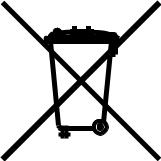
■ Internal laser radiation
Maximum radiation power: |
10 mW |
Wave length: |
780 - 800 nm |
Laser class: |
Class 3B |
■EU Directive 2002/96/EC and EN50419
(European Union only)
This equipment is marked with the recycling symbol below. It means that at the end of the life of the equipment you must dispose of it separately at an appropriate collection point and not place it in the normal domestic unsorted waste stream. This will benefit the environment for all. (European Union only)
|
|
|
|
|
|
|
|
|
|
|
|
|
|
|
|
|
|
|
|
|
|
|
|
|
|
|
|
|
|
|
|
|
|
|
|
|
|
|
|
|
|
|
|
|
|
|
|
|
|
|
|
|
ix |
Confidential |
|
<For USA and Canada>
■Federal Communications Commission (FCC) Declaration of Conformity (For USA)
Responsible Party: |
Brother International Corporation |
|
100 Somerset Corporate Boulevard |
|
P.O. Box 6911 |
|
Bridgewater, NJ 08807-0911 |
|
USA |
|
Telephone: (908) 704-1700 |
declares, that the products |
|
Product name: |
Laser Multi Function Center DCP-7030/7040/7045N, |
|
MFC-7320/7340/7440N/7450/7840N/7840W |
complies with Part 15 of the FCC Rules. Operation is subject to the following two conditions:
(1) This device may not cause harmful interference, and (2) this device must accept any interference received, including interference that may cause undesired operation.
This equipment has been tested and found to comply with the limits for a Class B digital device, pursuant to Part 15 of the FCC Rules. These limits are designed to provide reasonable protection against harmful interference in a residential installation. This equipment generates, uses, and can radiate radio frequency energy and, if not installed and used in accordance with the instructions, may cause harmful interference to radio communications. However, there is no guarantee that interference will not occur in a particular installation. If this equipment does cause harmful interference to radio or television reception, which can be determined by turning the equipment off and on, the end user is encouraged to try to correct the interference by one or more of the following measures:
•Reorient or relocate the receiving antenna.
•Increase the separation between the equipment and receiver.
•Connect the equipment into an outlet on a circuit different from that to which the receiver is connected.
•Consult the dealer or an experienced radio/TV technician for help.
Important
A shielded interface cable should be used to ensure compliance with the limits for a Class B digital device. Changes or modifications not expressly approved by Brother Industries, Ltd. could void the user’s authority to operate the equipment.
x |
Confidential |

■Industry Canada Compliance Statement (For Canada)
This Class B digital apparatus complies with Canadian ICES-003.
Cet appareil numérique de la classe B est conforme à la norme NMB-003 du Canada.
■Laser Safety (110 to 120 volt model only)
This machine is certified as a Class 1 laser product under the U.S. Department of Health and Human Services (DHHS) Radiation Performance Standard according to the Radiation Control for Health and Safety Act of 1968. This means that the machine does not produce hazardous laser radiation.
Since radiation emitted inside the machine is completely confined within protective housings and external covers, the laser beam cannot escape from the machine during any phase of user operation.
■FDA Regulations (110 to 120 volt model only)
The U.S. Food and Drug Administration (FDA) has implemented regulations for laser products manufactured on and after August 2, 1976. Compliance is mandatory for products marketed in the United States. The following label on the back of the machine indicates compliance with the FDA regulations and must be attached to laser products marketed in the United States.
MANUFACTURED:
Brother Technology (Shenzhen) Ltd.
NO6 Gold Garden Ind., Nanling Buji, Longgang, Shenzhen, China
This product complies with FDA performance standards for laser products except for deviations pursuant to Laser Notice No.50, dated Jun 24, 2007.
■ Internal laser radiation
Maximum radiation power: |
10 mW |
Wave length: |
780 - 800 nm |
Laser class: |
Class 3B |
xi |
Confidential |
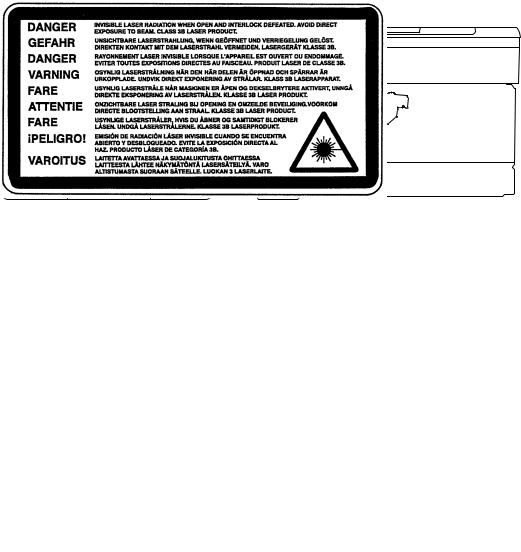
SAFETY INFORMATION
■ Caution for Laser Product (WARNHINWEIS fur Laser drucker)
CAUTION: |
When servicing the machine and it is operated with the cover open, the |
|
regulations of VBG 93 and the performance instructions for VBG 93 are |
|
valid. |
CAUTION: |
In case of any trouble with the laser unit, replace the laser unit itself. To |
|
prevent direct exposure to the laser beam, do not try to open the enclosure |
|
of the laser unit. |
ACHTUNG: |
Im Falle von Störungen der Lasereinheit muß diese ersetzt werden. Das |
|
Gehäuse der Lasereinheit darf nicht geöffnet werden, da sonst |
|
Laserstrahlen austreten können. |
<Location of the laser beam window>
■Additional Information
When servicing the optical system of the machine, be careful not to place a screwdriver or other reflective object in the path of the laser beam. Be sure to take off any personal accessories such as watches and rings before working on the machine. A reflected beam, though invisible, can permanently damage the eyes.
Since the beam is invisible, the following caution label is attached on the laser unit.
xii |
Confidential |
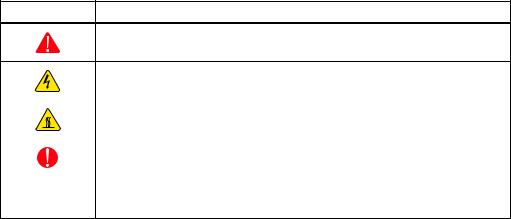
■ Definitions of Warnings, Cautions, Notes and Memos
The following conventions are used in this manual:
Mark |
Contents |
Warnings tell you what to do to prevent possible personal injury.
|
Electrical Hazard icons alert you to a possible electrical shock. |
|
|
|
Hot Surface icons warn you not to touch machine parts that are hot. |
|
|
|
Cautions specify procedures you must follow or avoid to prevent |
|
possible damage to the machine or other objects. |
|
|
Note |
Notes tell you useful tips when servicing the machine. |
|
|
Memo |
Memo tells you bits of knowledge to help understand the machine. |
xiii |
Confidential |

■ Safety Precautions
Please keep these instructions for later reference and read them before attempting any maintenance.
 WARNING
WARNING
There are high voltage electrodes inside the machine. Before you clean the inside of the machine, make sure you have unplugged the telephone line cord first and then the power cord from the AC power outlet (See Routine maintenance on page 115.)
DO NOT use flammable substances or any type of spray to clean the inside or outside of the machine. Doing this may cause a fire or electrical shock. Refer to Routine maintenance on page 115 for how to clean the machine.
DO NOT handle the plug with wet hands.
Doing this might cause an electrical shock.
Always make sure the plug is fully inserted.
After you have just used the machine, some internal parts of the machine will be extremely hot. When you open the front or back cover of the machine, DO NOT touch the shaded parts shown in the illustration.
The fuser unit is marked with a caution label.
Please DO NOT remove or damage the label.
xiv |
Confidential |
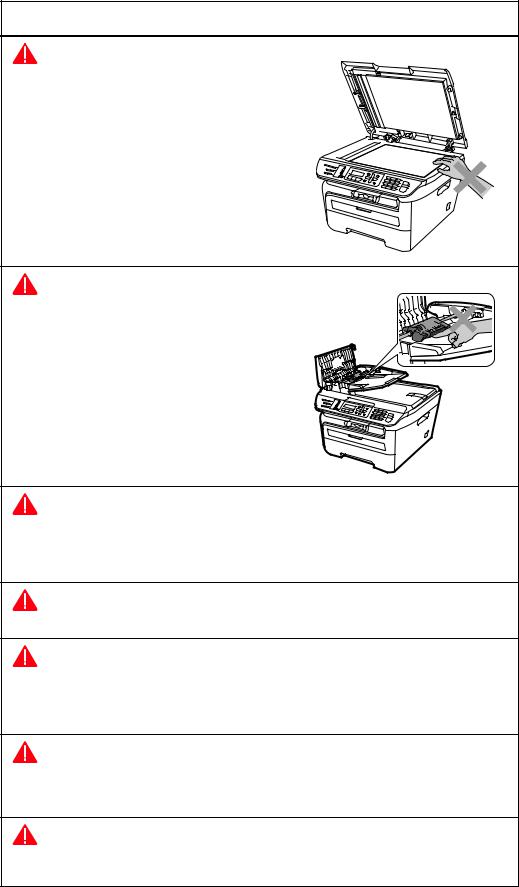
 WARNING
WARNING
To prevent injuries, be careful not to put your hands on the edge of the machine under the document cover or scanner cover.
To prevent injuries, be careful not to put your fingers in the area shown in the illustration.
DO NOT use a vacuum cleaner to clean up scattered toner. Doing this might cause the toner dust to ignite inside the vacuum cleaner, potentially starting a fire. Please carefully clean the toner dust with a dry, lint-free cloth and dispose of it according to local regulations.
When you move the machine, grasp the side hand holds that are under the scanner.
Use caution when installing or modifying telephone lines. Never touch telephone wires or terminals that are not insulated unless the telephone line has been unplugged at the wall jack. Never install telephone wiring during a lightning storm. Never install a telephone wall jack in a wet location.
This product must be installed near an AC power outlet that is easily accessible. In case of an emergency, you must disconnect the power cord from the AC power outlet to shut off the power completely.
To reduce the risk of shock or fire, use only a No. 26 AWG or larger telecommunication line cord.
xv |
Confidential |
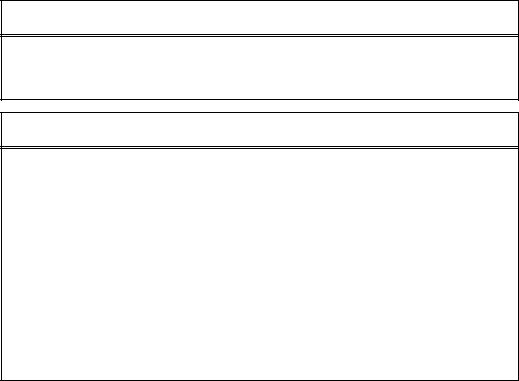
 CAUTION
CAUTION
Lightning and power surges can damage this product! We recommend that you use a quality surge protection device on the AC power line and on the telephone line, or unplug the cords during a lightning storm.
 WARNING
WARNING
IMPORTANT SAFETY INSTRUCTIONS
When using your telephone equipment, basic safety precautions should always be followed to reduce the risk of fire, electric shock and injury to people, including the following:
1DO NOT use this product near water, for example, near a bath tub, wash bowl, kitchen sink, washing machine, or in a wet basement or near a swimming pool.
2Avoid using this product during an electrical storm. There may be a remote risk of electric shock from lightning.
3DO NOT use this product to report a gas leak in the vicinity of the leak.
4Use only the power cord provided with the machine.
5DO NOT dispose of batteries in a fire. They may explode. Check with local codes for possible special disposal instructions.
SAVE THESE INSTRUCTIONS
xvi |
Confidential |
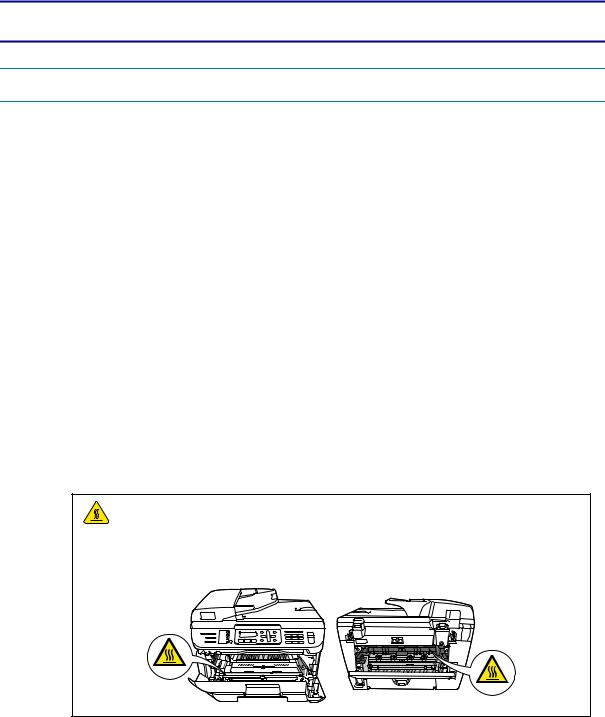
CHAPTER 1 TROUBLESHOOTING
1.INTRODUCTION
Troubleshooting is the countermeasure procedures that the service personnel should follow if an error or malfunction occurs with the machine. It is impossible to anticipate all of the possible problems which may occur in future and determine the troubleshooting procedures, so this chapter covers some sample problems. However, these samples will help the service personnel pinpoint and repair other defective elements.
1.1Precautions
Be sure to observe and follow all the precautions to prevent any secondary problems from happening during troubleshooting.
(1)Always turn off the power and unplug the power cable before removing any covers or PCBs, adjusting the machine and so on. If you need to take voltage measurements with the power switched on, take the greatest of care not to receive an electric shock.
(2)When connecting or disconnecting cable connectors, make sure that you hold the connector body and not the cables.
(3)Electronic devices are sensitive to static build up; make sure that you touch a metal portion of the machine to discharge yourself before accessing the PCBs.
Handle PCBs with care when repairing them.
(4)Ensure all Warnings are followed.
The fuser unit becomes extremely hot during operation. Wait until it has cooled down sufficiently before replacing consumable items. DO NOT remove or damage the caution label located on or around the fuser.
(5) Verify again that the repaired portion works properly.
1-1 |
Confidential |
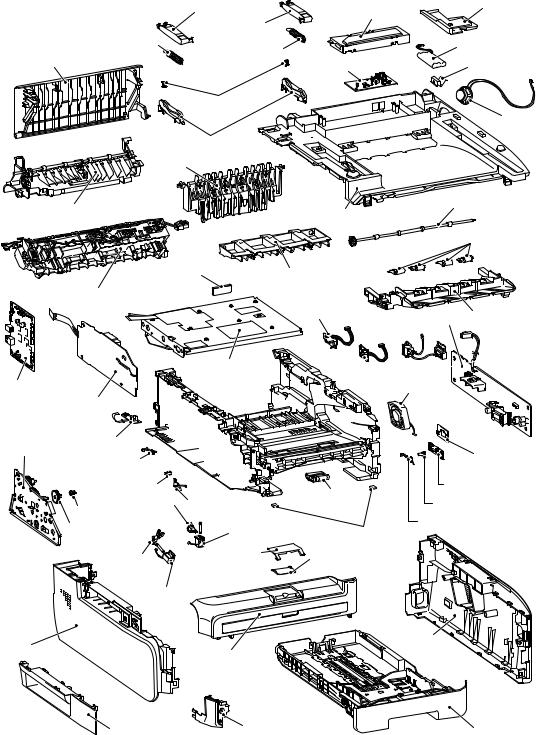
1.2Part names
■Printer part
|
|
Pull arm R |
NCU shield |
Speaker cover |
|
|
Pull arm L |
|
|
Pull arm spring ADF R |
Pull arm spring ADF |
|
Battery ASSY |
|
|
|
|
||
Back cover |
|
NCU PCB |
|
Speaker hold spring |
|
|
|
||
|
|
|
|
|
|
|
Lock claw |
|
|
|
|
|
|
Speaker unit |
|
|
Pull arm guide |
|
|
|
Outer chute ASSY |
|
|
|
Fuser cover |
|
Joint cover ASSY |
|
Eject roller ASSY 2 |
Paper stack lever |
Filter ASSY |
Joint cover sub chute ASSY |
Fuser unit
Registration rear |
Inner chute ASSY |
|
sensor PCB ASSY |
||
|
||
|
PS PCB unit ASSY |
Laser unit 
 Registration front
Registration front
sensor PCB ASSY
Main PCB ASSY
Fan motor High-voltage 60 unit
PS PCB ASSY
Eject sensor PCB ASSY |
|
|
|
|
Drive sub ASSY |
|
|
|
Wireless LAN |
New toner sensor |
|
|
||
|
|
PCB ASSY |
||
harness ASSY |
|
|
||
|
|
|
||
PT sensor holder |
|
Roller holder |
Toner LED PCB ASSY |
|
|
|
Toner sensor PCB |
|
|
DEV joint |
T1 solenoid |
ASSY |
LED holder |
|
unit ASSY |
|
|
||
|
lever |
|
|
Cover sensor harness ASSY |
DEV gear |
|
T1 solenoid |
|
|
|
|
|
||
joint/53R |
|
Rubber foot |
|
|
|
|
|
||
Registration |
Paper |
Paper |
|
|
stopper L |
|
|||
solenoid lever |
|
|||
|
stopper S |
|
||
|
|
|
|
|
|
Registration |
|
|
|
|
solenoid |
|
|
|
|
|
|
|
Side cover |
Side cover L ASSY |
|
|
|
R ASSY |
|
Front cover ASSY |
|
|
|
|
|
|
|
|
Side cover sub L |
Corner cover |
Paper tray ASSY |
|
Fig. Ref. 1-1
1-2 |
Confidential |

■ ADF / FB part
Gear cover
Panel dress cover
ADF cover
Address label
Panel unit
Separate roller shaft ASSY |
Separate roller bushing |
Separation rubber
LCD
ADF plate spring |
Diffusion film |
Back light guide 
Rubber key R
Upper document chute ASSY
Rubber key L
Pressure roller ASSY
Pressure roller spring
 Hinge R
Hinge R
Hinge arm
Hinge ASSY L
Panel PCB ASSY
Document stopper
Ejection roller ASSY |
|
|
|
Document dress cover |
|
LF roller ASSY |
|
|
|
Document cover sub ASSY |
|
LF roller bushing |
Cord hook |
|
|
||
Drive frame ASSY |
Actuator R |
|
Actuator L |
|
|
ADF harness unit |
|
|
ADF motor |
|
|
|
ADF sensor |
|
|
PCB ASSY |
|
harness holder |
Document scanner unit |
|
Lower document chute ASSY |
||
|
Fig. Ref. 1-2
1-3 |
Confidential |
1.3Initial Check
Check the following items before attempting to repair the machine.
■Operating Environment
(1)Put your machine on a flat, stable surface such as a desk that is free of vibration and shocks.
(2)Use the machine in a well-ventilated room; use the machine within the following ranges of temperature and humidity: temperature between 10°C and 32.5°C (50°F to 90.5°F), and the relative humidity is maintained between 20% and 80%.
(3)The machine is not exposed to direct sunlight, excessive heat, moisture, or dust.
■Power Supply
(1)The AC input power supply described on the rating plate of the machine should be within
±10% of the rated voltage.
(2)The AC input power supply is within the regulated value.
(3)The cables and harnesses are connected correctly.
(4)The fuses are not blown.
■Paper
(1)A recommended type of paper is being used.
(Refer to “2.6 Paper”, Reference 1 of the Service Reference Manual.)
(2)The paper is not damp.
(3)The paper is not short-grained paper or acid paper.
■Consumable Parts
(1)The drum unit (including the toner cartridge) is installed correctly.
■Others
(1)Condensation
When the machine is moved from a cold place into a warm room, condensation may occur inside the machine, causing various problems as listed below.
•Condensation on the optical surfaces such as the scanner window, lenses, the reflection mirror and the protection glass may cause the print image to be light.
•If the exposure drum is cold, the electrical resistance of the photosensitive layer is increased, making it impossible to obtain the correct contrast when printing.
•Condensation on the charge unit may cause corona charge leakage.
•Condensation on the plate and separation pad may cause paper feed failures.
If condensation has occurred, leave the machine for at least 2 hours to allow it to reach room temperature.
If the drum unit is unpacked soon after it is moved from a cold place to a warm room, condensation may occur inside the unit which may cause incorrect images. Instruct the end user to allow the unit to come to room temperature before unpacking it. This will take one or two hours.
1-4 |
Confidential |

(2)Cleaning
Use a soft dry cloth.
CAUTION:
DO NOT use flammable substances or any type of spray to clean the inside or outside of the machine. Doing this may cause a fire or electrical shock.
1-5 |
Confidential |

2.ERROR CAUSE
This machine includes a self-diagnosis function. If the machine does not work normally it judges that an error has occurred (For example: Print Unable 6A), and indicates the corresponding error message on the LCD, which in turn helps the end user to quickly identify the problem.
The error code is possible to display by the Maintenance mode 82 (Refer to "1.4.19 Error Code Indication (Function code 82)" in Chapter 5).
2.1Error indication
The error codes shaded in the table below are recoverable errors if you follow the User Check items.
Error |
Problem |
Refer |
Error |
Problem |
Refer |
|
codes |
to: |
codes |
to: |
|||
|
|
|||||
|
|
|
|
|
|
|
50 |
Replacement time of the drum |
1-7 |
7B |
Main PCB failure |
1-13 |
|
unit |
||||||
|
|
|
|
|
||
|
|
|
|
|
|
|
56 |
Fuser cover opened |
1-8 |
7D |
Dirt on drum unit |
1-14 |
|
|
|
|
|
|
|
|
58 |
Fuser unit failure |
1-8 |
7F |
Fax paper setting mismatch |
1-14 |
|
(Stand ready in the given time) |
||||||
|
|
|
|
|
||
|
|
|
|
|
|
|
59 |
Fuser unit failure |
1-8 |
80 |
Fax paper size is small |
1-14 |
|
|
|
|
|
|
|
|
5A |
HVPS PCB ASSY failure |
1-9 |
84 |
Paper jam in rear of the machine |
1-16 |
|
|
|
|
|
|
|
|
5B |
New toner detecting lever |
1-9 |
88 |
Paper jam inside the machine |
1-16 |
|
malfunction |
||||||
|
|
|
|
|
|
|
63 |
Toner cartridge is at the end of life. |
1-10 |
8A |
Paper jam in Tray 1 (T1) |
1-17 |
|
|
|
|
|
|
|
|
67 |
Toner of the toner cartridge is |
1-7 |
8D |
Paper jam near paper eject tray |
1-17 |
|
low |
||||||
|
|
|
|
|
||
68 |
Fuser unit failure |
1-11 |
9F |
Paper empty |
1-18 |
|
|
|
|
|
|
|
|
69 |
Fuser unit failure |
1-11 |
A1 |
Front cover open |
1-18 |
|
|
|
|
|
|
|
|
6A |
Fuser unit failure |
1-11 |
A2 |
Document is too long. |
1-18 |
|
|
|
|
|
|
|
|
|
|
|
|
Document rear sensor is not |
|
|
6B |
Fuser unit failure |
1-11 |
A3 |
turned on when feeding the |
1-19 |
|
|
|
|
|
document. |
|
|
|
|
|
|
|
|
|
6C |
Fuser unit failure |
1-11 |
A5 |
Fax scanning error |
1-19 |
|
|
|
|
|
(First warning only) |
|
|
|
|
|
|
Fax scanning error (The second |
|
|
6D |
Fuser unit failure |
1-11 |
A6 |
warning that the same error with |
1-19 |
|
|
|
|
|
A5 occurs again) |
|
|
|
|
|
|
|
|
|
6E |
Fuser unit failure |
1-11 |
AD |
DMA transfer error |
1-19 |
|
|
|
|
|
|
|
|
6F |
Fuser unit failure |
1-11 |
AF |
FB unit home position failure |
1-20 |
|
|
|
|
|
|
|
|
71 |
Polygon motor failure |
1-12 |
B0 |
Harness for scanning is not |
1-20 |
|
|
|
|
|
connected correctly. |
|
|
72 |
BD beam detecting sensor |
1-12 |
B7 |
Detection error of scanner |
1-20 |
|
malfunction |
||||||
|
|
|
|
|
||
|
|
|
|
|
|
|
75 |
Machine cooling down inside |
1-7 |
B9 |
Scanning light adjustment error. |
1-20 |
|
|
|
|
|
|
|
|
76 |
Fuser unit failure |
1-12 |
BB |
White level data error |
1-21 |
|
|
|
|
|
|
|
|
77 |
Fuser unit failure |
1-12 |
E6 |
NVRAM error on main PCB |
1-21 |
|
|
|
|
|
|
|
|
78 |
Fuser unit failure |
1-13 |
EC |
Fan performance malfunction |
1-21 |
|
|
|
|
|
|
|
|
79 |
No detection of the internal |
1-13 |
F8 |
Battery connection failure |
1-21 |
|
temperature thermistor |
||||||
|
|
|
|
|
||
|
|
|
|
|
|
|
7A |
No detection of main motor lock |
1-13 |
F9 |
Maintenance mode 74 Non- |
1-22 |
|
signal |
decision |
|||||
|
|
|
|
|
|
1-6 |
Confidential |
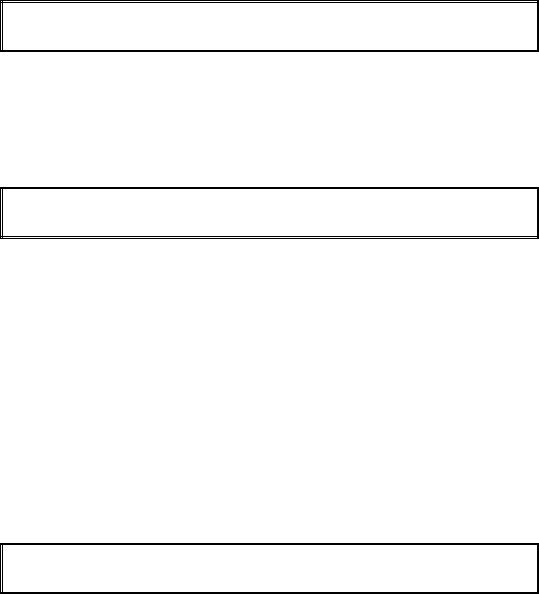
2.2Error Code Cause and Remedy
2.2.1 Recoverable User Check Errors
These errors are recoverable by following the message indicated on the LCD or following the items indicated in User Check.
■ Error code 67
Toner Low
Prepare New Toner Cartridge
The toner of the toner cartridge is low. (The toner sensor delects the nearly empty.)
User Check
•Prepare a new toner cartridge. If the toner is empty, Replace it.
■Error code 75
Cooling Down
Wait for a while
The machine is cooling down inside for protection.
The machine indicates "Cooling Down" in one of the conditions below.
(1)The temperature inside the machine is too high.
(2)Both ends of the heat roller are at different temperatures.
(3)The paper media is replaced with different Paper size media.
User Check
•After having passed for a while with having turned the power supply on.
2.2.2Service Call Error
Check the User Check items first. If the same problem occurs follow each procedure in the order of the number described in the Step column in the table below.
■Error code 50
Drum End Soon
Replacement time of the drum unit. (The drum counter reached the upper limit.)
User Check
• Replace the drum unit with a new one.
Step |
Cause |
Remedy |
|
|
|
|
|
|
1 |
Main PCB failure |
Replace the main PCB ASSY. |
|
|
|
1-7 |
Confidential |
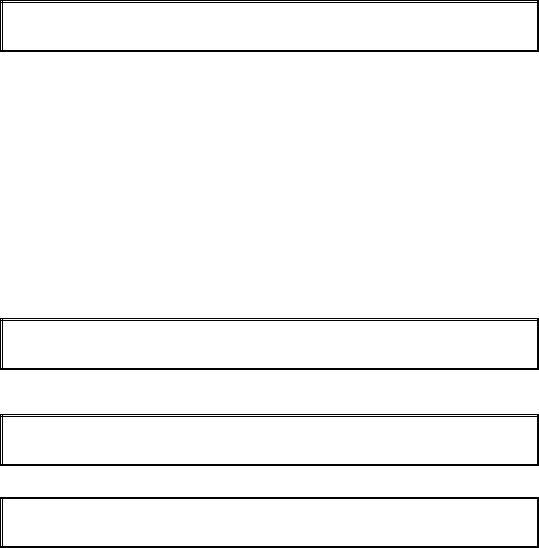
■ Error code 56
Cover is Open
Close the Fuser Cover.
Fuser cover opened
User Check
• Check if the Fuser cover is closed correctly.
Step |
Cause |
Remedy |
|
|
|
|
|
|
|
|
|
1 |
Harness connection failure of back |
Check the harness connection of the back |
|
cover switch ASSY |
cover switch ASSY and reconnect it. |
||
|
|||
|
|
|
|
2 |
Eject actuator failure |
Re-assemble the eject actuator |
|
|
|
|
|
3 |
Eject sensor PCB ASSY failure |
Replace the eject sensor PCB ASSY. |
|
|
|
|
|
4 |
Main PCB failure |
Replace the main PCB ASSY. |
|
|
|
|
■ Error code 58
Fuser Error
Turn the power off, then on again. Leave the machine for 15 min.
Error code 59
Self-Diagnostic
Will Automatically Restart within 15 minutes.
If the same error is detected again 15 minutes later, the message below is indicated.
Print Unable 6A
See Troubleshooting and routine maintenance chapter in User’s Guide.
Fuser unit failure |
*It occurs with either of 68, 69, 6A, 6B, 6C, 6D, 6E, 6F, 76 and 78. |
||
|
|
|
|
Step |
|
Cause |
Remedy |
|
|
|
|
|
|
|
|
|
Harness connection failure |
Check the harness connection between the |
|
1 |
between fuser unit and eject |
fuser unit and eject sensor PCB, and |
|
|
sensor PCB |
|
reconnect it. |
|
|
|
|
2 |
Fuser unit failure |
Replace the fuser unit. |
|
|
|
|
|
3 |
LVPS PCB failure |
Replace the LVPS PCB unit. |
|
|
|
|
|
4 |
Eject sensor PCB ASSY failure |
Replace the eject sensor PCB ASSY. |
|
|
|
|
|
5 |
Main PCB failure |
Replace the main PCB ASSY. |
|
|
|
|
|
1-8 |
Confidential |

■ Error code 5A
Print Unable 5A
See Troubleshooting and routine maintenance chapter in User’s Guide.
HVPS PCB failure (Developing bias voltage failure)
Step |
Cause |
Remedy |
|
|
|
|
|
|
|
HVPS PCB ASSY harness |
Check the harness connection between the |
1 |
connection failure |
HVPS PCB and main PCB. Then, |
|
|
reconnect them. |
|
|
|
2 |
HVPS PCB failure |
Replace the HVPS PCB ASSY. |
|
|
|
3 |
Main PCB failure |
Replace the main PCB ASSY. |
|
|
|
■ Error code 5B
Cartridge Error
Put the Black Toner Cartridge back in.
New toner detection lever malfunction
User Check
• Check if the toner cartridge is attached.
Step |
Cause |
Remedy |
|
|
|
|
|
|
|
|
|
1 |
New toner detection switch |
Check the harness connection of the new |
|
harness connection failure |
toner detection switch. Then, reconnect it. |
||
|
|||
|
|
|
|
2 |
New toner detection switch failure |
Replace the new toner harness ASSY. |
|
|
|
|
|
3 |
Main PCB failure |
Replace the main PCB ASSY. |
|
|
|
|
1-9 |
Confidential |

■ Error code 63
Toner Life End
Replace Toner Cartridge.
Toner cartridge is at the end of its life.
(The toner sensor detects the nearly empty, or the drum counter reached the upper limit.)
User Check
•Gently shake the toner cartridge from side to side and install it again.
•Replace the toner cartridge.
Step |
Cause |
Remedy |
|
|
|
|
|
|
Harness connection failure of new |
Check the sensor performance following |
|
|
toner sensor harness ASSY. |
the procedure described in "Maintenance |
|
1 |
|
mode 32". If any problem occurs, check the |
|
|
|
harness connection of the new toner |
|
|
|
sensor harness ASSY, then reconnect it. |
|
|
|
|
|
|
Harness connection failure of |
Check the sensor performance following |
|
|
toner sensor PCB unit ASSY. |
the procedure described in "Maintenance |
|
2 |
|
mode 32". If any problem occurs, check the |
|
|
|
harness connection of the toner sensor |
|
|
|
PCB unit ASSY, then reconnect it. |
|
|
|
|
|
3 |
New toner sensor harness ASSY |
Replace the new toner sensor harness |
|
failure (Toner empty) |
ASSY. |
||
|
|||
|
|
|
|
4 |
Toner sensor PCB unit ASSY |
Replace the toner sensor PCB unit ASSY. |
|
failure. |
|
||
|
|
||
|
|
|
|
5 |
Main PCB failure |
Replace the main PCB ASSY. |
|
|
|
|
1-10 |
Confidential |
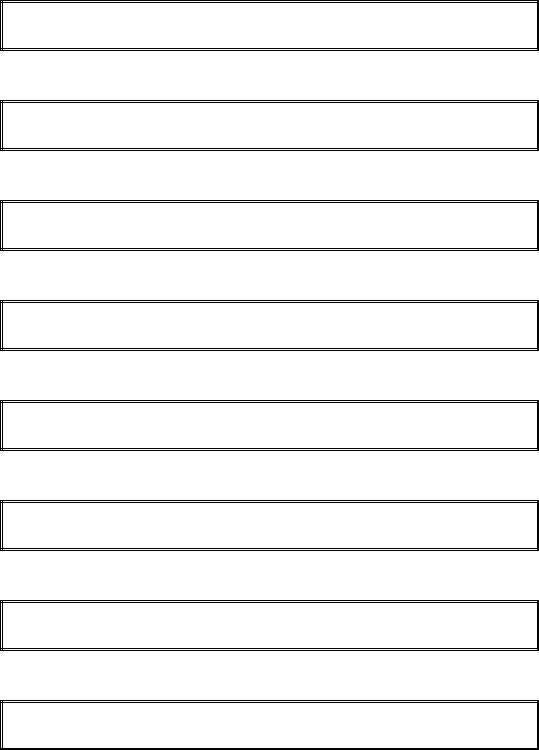
■ Error code 68
Print Unable 68
See Troubleshooting and routine maintenance chapter in User’s Guide.
Fuser unit failure (The side thermistor detects higher temperature than the specified value.)
Error code 69
Print Unable 69
See Troubleshooting and routine maintenance chapter in User’s Guide.
Fuser unit failure (The side thermistor detects lower temperature than the specified value.)
Error code 6A
Print Unable 6A
See Troubleshooting and routine maintenance chapter in User’s Guide.
Fuser unit failure (The side thermistor does not detect 60°C within the specified time.)
Error code 6B
Print Unable 6B
See Troubleshooting and routine maintenance chapter in User’s Guide.
Fuser unit failure (The center thermistor does not detect 100°C within the specified time.)
Error code 6C
Print Unable 6C
See Troubleshooting and routine maintenance chapter in User’s Guide.
Fuser unit failure (The center thermistor detects higher temperature than the specified value.)
Error code 6D
Print Unable 6D
See Troubleshooting and routine maintenance chapter in User’s Guide.
Fuser unit failure (The center thermistor detects lower temperature than the specified value.)
Error code 6E
Print Unable 6E
See Troubleshooting and routine maintenance chapter in User’s Guide.
Fuser unit failure (The center thermistor does not detect temperature rising within the specified time.)
Error code 6F
Print Unable 6F
See Troubleshooting and routine maintenance chapter in User’s Guide.
Fuser unit failure (The center and side thermistors detect extremely high temperature.)
Step |
Cause |
Remedy |
|
|
|
|
|
|
|
|
|
1 |
Fuser unit harness connection |
Check the harness connection of the fuser |
|
failure |
unit and reconnect it. |
||
|
|||
|
|
|
|
2 |
Fuser unit failure |
Replace the fuser unit. |
|
|
|
|
|
3 |
LVPS PCB unit failure |
Replace the LVPS PCB unit. |
|
|
|
|
|
4 |
Main PCB failure |
Replace the main PCB ASSY. |
|
|
|
|
1-11 |
Confidential |
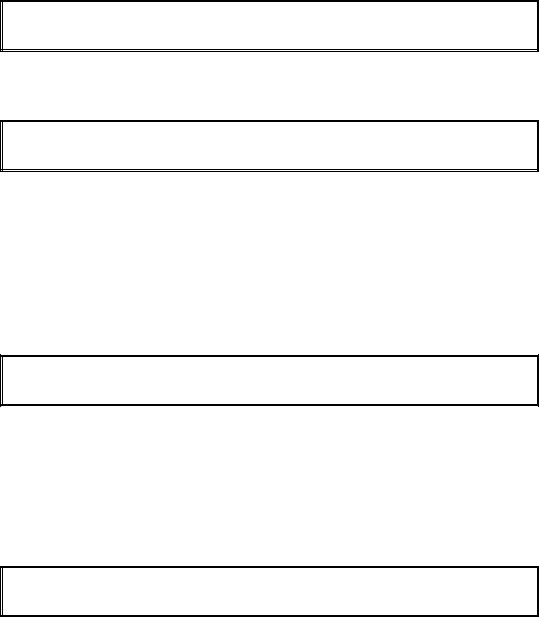
■ Error code 71
Print Unable 71
See Troubleshooting and routine maintenance chapter in User’s Guide.
Laser unit Polygon mirror motor failure
(Cannot detect the period signal of the polygon mirror motor.)
Error code 72
Print Unable 72
See Troubleshooting and routine maintenance chapter in User’s Guide.
BD beam detect sensor malfunction
Step |
Cause |
Remedy |
|
|
|
|
|
|
|
|
|
1 |
Laser unit harness connection |
Check the two harness connections of the |
|
failure |
laser unit and reconnect them. |
||
|
|||
|
|
|
|
2 |
Laser unit failure |
Replace the laser unit. |
|
|
|
|
|
3 |
Main PCB failure |
Replace the main PCB ASSY. |
|
|
|
|
■ Error code 76
Print Unable 76
See Troubleshooting and routine maintenance chapter in User’s Guide.
Fuser unit failure (The center thermistor detects rapidly rising temperature.)
Step |
Cause |
Remedy |
|
|
|
|
|
|
|
|
|
1 |
Fuser unit harness connection |
Check the harness connection of the fuser |
|
failure |
unit and reconnect it. |
||
|
|||
|
|
|
|
2 |
Fuser unit failure |
Replace the fuser unit. |
|
|
|
|
■ Error code 77
Print Unable 77
See Troubleshooting and routine maintenance chapter in User’s Guide.
Fuser error code failure (The error history of the fuser unit is deleted.)
Step |
Cause |
Remedy |
|
|
|
1 |
Fuser unit failure |
Replace the fuser unit. |
|
|
|
2 |
Main PCB failure |
Replace the main PCB ASSY. |
|
|
|
1-12 |
Confidential |
